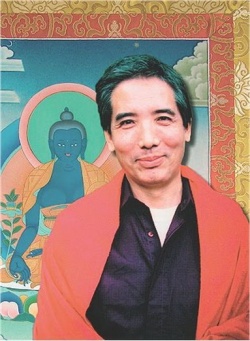Influence of Yogacara on Tantra by Ven. Traleg Rinpoche
Shared Concepts of Yogacara and Mahamudra
We are going to be talking about the relationship of Yogacara philosophy to Buddhist tantra. People have generally ignored how Yogacara philosophy influenced Buddhist tantra and its development. Even though it's quite patent in the writings of Buddhist tantra, it is not discussed explicitly. You could trace different notions discussed in the tantric literature back to Yogacara philosophy.
Yogacara philosophy itself developed as a reaction against too much theorization. It came to emphasize individual experience and practice, hence the name Yogacara, meaning practitioners of yoga. Yoga here doesn't mean twiddling with your toes, but meditation. So Yogacara, practitioners of yoga, meaning meditators. Yogacara as a system was developed by two brothers known as Asanga and Vasubandhu. They developed the philosophy in such a way that everything came back to one's practice, to one's experience. You could not theorize about Yogacara philosophy without meditating. In fact, you could not be a Yogacara philosopher unless you meditate. When we look at the writings of Yogacara philosophy, we discover many tantric concepts mentioned, either implicitly or explicitly.
There are certain crucial concepts that Yogacara philosophy and Buddhist tantra share, concepts such as transforming unhealthy or unwholesome psychological aspects of oneself into something higher. In other words, all our negativities - emotions such as passion, aggression, ignorance, stupidity, confusion, whatever they may be - are not perceived as being something that should be dispensed with, as much as transformed or mutated. The nature of one's psychological makeup is not altered, but the way the negativities manifest becomes totally different. This is a very important tantric concept, as many of you might know. Transforming one's neuroses and emotional instabilities are very much part of tantra - not to reject what is bothering you, but to learn to accept and transform it. In fact, you can trace those ideas to the original Yogacarin writings.
Questions related to "Shared Concepts".
The Enlightened Nature of Being
A second concept, again a very important one common to Yogacara philosophy and Buddhist tantra, is emphasis on the enlightened nature of every human being. Both Yogacara tradition and the tantric school emphasize the fact that every single human being is fundamentally enlightened. Ignorance or confusion is totally incidental or contingent. They are not at all intrinsic to human nature. In fact, human nature is believed to be totally enlightened and sane. No amount of negativities or emotional instabilities, whatever they may be, can corrupt that basic intrinsic intelligence or wisdom, that basic enlightened nature. In Yogacara writings, this is known as tathagatagarbha. Tathagatagarbha actually means womb of enlightenment. Enlightened nature exists as a potentiality, as a womb has the potential to accommodate a being. Every human being possesses tathagatagarbha, this womb of enlightenment. Normally, tathagatagarbha is translated as Buddha-nature.
The notion of Buddha-nature is actually a Yogacarin concept. Buddhists tend to associate Buddha-nature with the Mahayana in general, but that is not true. Not all Mahayana schools would go along with this notion. The Madhyamika school, for instance, rejects the notion of tathagatagarbha altogether, because for them it is still a concept. Madhyamikans reject any kind of metaphysical concept. For them, the tathagatagarbha notion is, as they say, taught by the Buddha only for beginners, so that, gradually, they will wake up to the fact that Madhyamika is the answer. So, it's just a warm up exercise, an entree, whereas the main course is yet not presented. The tantric tradition uses the notion of tathagatagarbha, but it is expressed in a different way and is called clear light or something like that. Clear light is not a particularly good translation, I don't think. In Tibetan, it is called 'od gsal, clear light or luminosity. That is the same concept as tathagatagarbha. You also have the fundamental sense of incorruptibility of human nature. This is an aspect that we could get into as we go along.
The Notion of Shunyata - Emptiness
The next important concept is the notion of sunyata, which means emptiness. Sunyata normally has a negative connotation, meaning things do not have any inherent existence or do not have any substantiality. The lack of that substantiality is emptiness. In Yogacara philosophy, emptiness begins to assume a positive connotation. This is also true in tantra. Emptiness is no longer regarded as the total negation of the substantiality of things. In fact, emptiness begins to assume the role of being the absolute, the ground upon which the phenomenal world functions and exists. So, it becomes an affirmation of negation. That is very interesting, because normally, if you negate something, that's the end of it. In the Yogacarin and tantric concept, negation itself becomes the affirmation of something that we don't normally have access to. It is a reality that can be perceived and tuned into, not through ordinary means of knowledge, but through a higher form of knowledge. As you begin to transform your negativities into something positive and higher, then, as you proceed, you also begin to apprehend reality or sunyata in a much more precise way
In tantra, sunyata is even called the unshakable vajra. It's so real and solid that we can't deny its existence. To say that in strict Madhyamikan terms would be shocking. When the chair you sit on is insubstantial and the glass that you drink from is insubstantial, how could emptiness, which you can't even see, be more solid and real than what we are experiencing now? Tantrikas and Yogacarins almost, in some ways, substantialise the notion of emptiness. It becomes the ground or the reality upon which the phenomenal or relative world exists.
The Workings of the Mind
The last concept that we will discuss is the emphasis that both schools place on the workings of the mind. Yogacarins and Tantrikas do not speculate about the world. They reduce both subject and object to the workings of the mind. Our understanding of the phenomenal world is due to the mind. Whatever we experience, in terms of subject and object duality, is due to the mind. So, mind is the cause from which everything stems. Both schools share this view. It is said that mind not only creates subject and object, but also samsara and nirvana. Liberation is attained due to the mind and we get bound in samsara due to the mind. No matter whether we are freed or bound, it is all due to the workings of the mind. Liberation can be achieved only by working with and transforming negative states of mind, whatever they are, into something much more positive. These are the points that we will be going into in some detail in this course. As we go along, we could take each point, one by one, and gradually try to absorb it. The connection between tantra and Yogacara has not been discussed enough. I'm not going to go into any in-depth analysis, which is impossible due to time constraints and also my own lack of ability. You can't expect too much, but we can do our best.
As far as the tantric side is concerned, we are not going to discuss the lower Tantras too much, because they are ritually, rather than philosophically, oriented. What we are concerned about are philosophical concepts, not about how you should blow a trumpet or breathe through your nose. We are not going into that and we are not going to discuss visualizations. We'll mainly be concerned with the highest tantra, the anuttarayoga-tantra, which is connected with the tradition of Mahamudra. So, we will be comparing and contrasting Mahamudra teachings with Yogacara philosophy, with how they inter-relate and interact.

